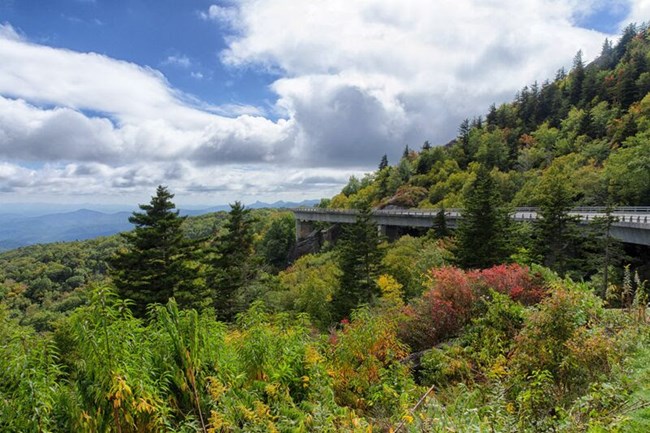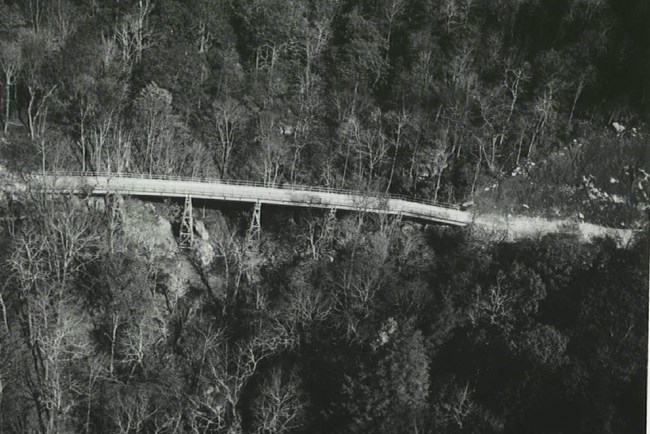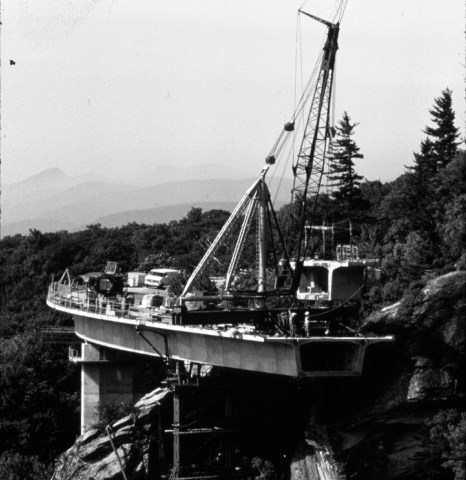
Jim Ruff photo Viaducts are elevated roadway sections carrying the road high above dry ravines or across the shoulders of mountains where extensive and aesthetically unpleasing fill sections would otherwise be required. The earliest of these is the Rocky Mountain Viaduct, constructed in 1937, on the northern section of the parkway at milepost 35. This steel girder structure is supported by arched stone piers and stone-faced abutments, and is the only viaduct to feature this treatment. Most other parkway viaducts are steel girder structures supported by reinforced concrete or steel piers. Text excerpted from "Highways in Harmony" publication produced by Historic American Engineering Record (HAER), in cooperation with the National Park Foundation 
Kristina Plaas photo As the last piece of the parkway to be completed, the Linn Cove Viaduct is a marvelous feat of engineering and environmental protection. Completed in 1983, at a cost of almost $10 million, the Linn Cove Viaduct is 1,243 feet long and contains 153 segments weighing 50 tons each. The American Society of Civil Engineers designated it a National Civil Engineering Landmark. Establishing the RouteThe exact route location of this segment, commonly referred to as the "missing link,” created a lengthy and heated controversy between private individuals and the National Park Service. Finally, North Carolina Governor Dan K. Moore negotiated a compromise location. A key factor in this controversy was environmental concern over Grandfather Mountain. Engineers were faced with a serious question: How do you build a road at an elevation of 4,100 feet without damaging one of the world's oldest mountains? 
Constructing with CareIn order to prevent environmental damage and to allow construction to continue during severe winter weather, builders pre-cast sections indoors a few miles from the site using a process known as "match casting." Each new segment was cast against the segment preceding it.The viaduct itself was the only access road for construction. Each pre-cast section was lowered by a stiff-leg crane and epoxied into position against the preceding segment. Steel cables threaded through the segments secured the entire bridge deck. The viaduct was constructed from the top down to minimize disturbance to the natural environment. This method eliminated the need for a "pioneer road" and heavy equipment on the ground. The only construction that occurred at ground level was the drilling of foundations for the seven permanent piers, on which the Viaduct rests. Exposed rock was covered to prevent staining from concrete, epoxy, or grout. Tinted with iron oxide, the concrete blends in with the existing rock outcroppings. The only trees cut were those directly beneath the superstructure. 
Timeline of CompletionAlthough the Blue Ridge Parkway’s construction began in 1935, construction of the Linn Cove Viaduct was delayed until 1979, when Congress finally approved funding. In the meantime, other portions of the "missing link," most of them north of the Viaduct, were completed bit-by-bit between 1968 and 1987. In addition to 12 bridges, the 7.5 mile section includes a dozen parking overlooks and the 13.5 mile Tanawha Trail, stretching from Beacon Heights to Julian Price Park. |
Last updated: August 24, 2022
